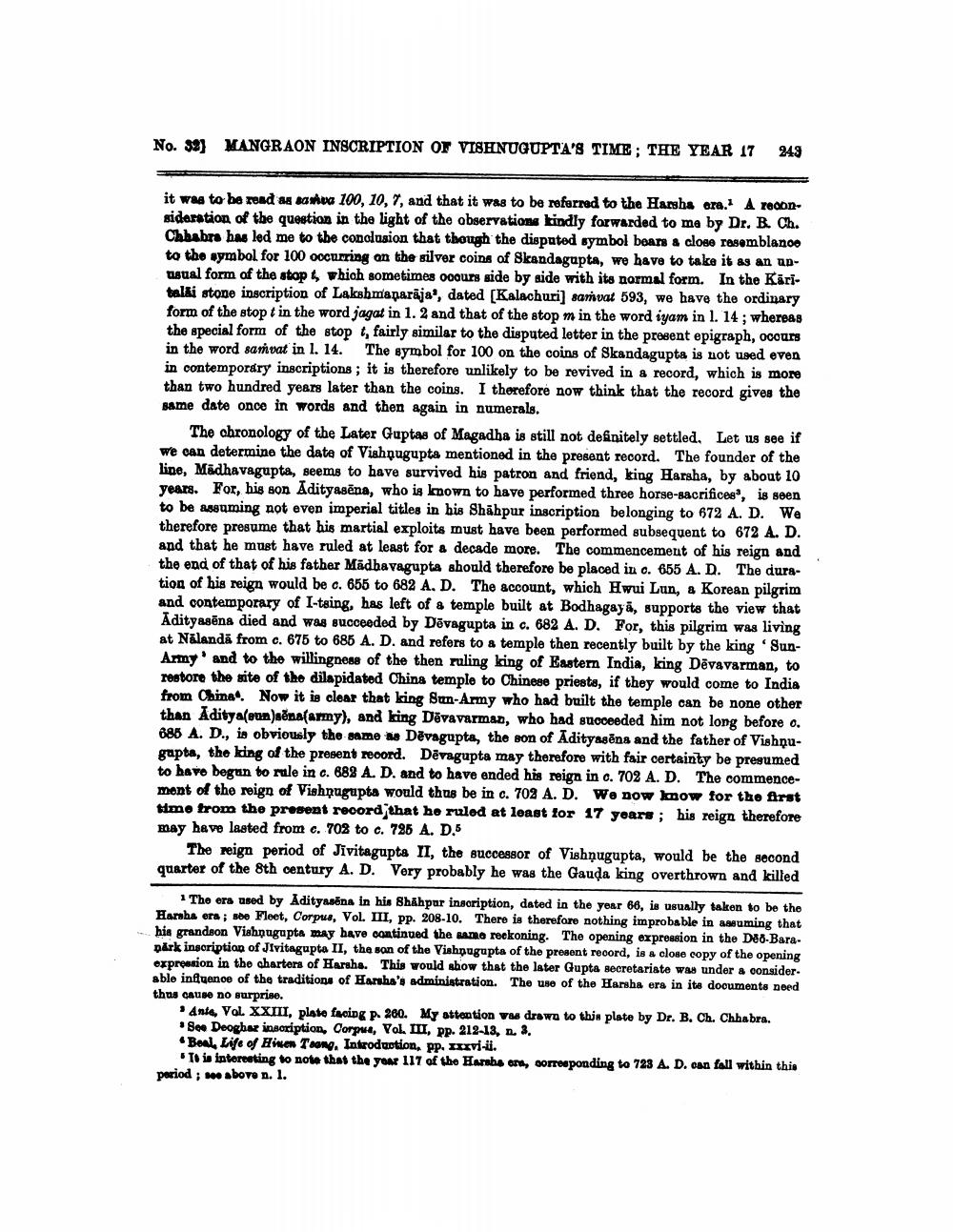________________
No. 32) MANGRAON INSCRIPTION OF VISHNUGUPTA'S TIME; THE YEAR 17
243
it was to be read as aanwa 100, 10, 7, and that it was to be referred to the Harsha era. A reconsideration of the question in the light of the observations kindly forwarded to ma by Dr. B. Ch. Chhabra has led me to the conclusion that though the disputed symbol bears a close resemblanco to the symbol for 100 occurring on the silver coins of Skandagupta, we have to take it as an upusual form of the stop, which sometimes occurs side by side with its normal form. In the Karitalki stone inscription of Lakshmanarāja', dated (Kalachuri) samvat 593, we have the ordinary form of the stop t in the word jagat in 1. 2 and that of the stop m in the word iyam in l. 14 ; whereas the special form of the stop , fairly similar to the disputed letter in the present epigraph, cours in the word samvat in l. 14. The symbol for 100 on the coins of Skandagupta is not used even in contemporary inscriptions; it is therefore unlikely to be revived in a record, which is more than two hundred years later than the coins. I therefore now think that the record gives the same date once in words and then again in numerals.
The chronology of the Later Guptas of Magadha is still not definitely settled. Let us see if we oan determine the date of Vishnugupta mentioned in the present record. The founder of the line, Mädhavagupta, seems to have survived his patron and friend, king Harsha, by about 10 years. For, his son Adityasēna, who is known to have performed three horse-sacrifices', is seen to be assuming not even imperial titles in his Shāhpur inscription belonging to 672 A. D. We therefore presume that his martial exploits must have been performed subsequent to 672 A. D. and that he must have ruled at least for a decade more. The commencement of his reign and the end of that of his father Madhavagupta should therefore be placed in c. 655 A. D. The duration of his reign would be c. 655 to 682 A. D. The account, which Hwui Lun, a Korean pilgrim and contemporary of I-tsing, has left of a temple built at Bodhagayā, supports the view that Adityasēna died and was succeeded by Dēvagupta in c. 682 A. D. For, this pilgrim was living at Nalandā from c. 675 to 686 A. D. and refers to & temple then recently built by the king 'SunArmy and to the willingness of the then ruling king of Eastern India, king Dēvavarman, to restore the site of the dilapidatod China temple to Chinese prieste, if they would come to India from China. Now it is clear that king Sun-Army who had built the temple can be none other than Adityaleun) nafarmy), and king Dēvavarman, who had succeeded him not long before o. 886 A. D., is obviously the same as Dēvagupta, the son of Adityasēns and the father of Vishņugapta, the king of the present record. Dēvagupta may therefore with fair certainty be presumed to have begun to rule in c. 688 A. D. and to have ended his reign in o. 702 A. D. The commencemont of the reign of Vishnugupta would thus be in c. 702 A. D. We now know for the first time from the present record that he ruled at least for 17 years; his reign therefore may have lasted from c. 702 to c. 726 A. D.5
The reign period of Jivitagupta II, the successor of Vishnugupta, would be the second quarter of the 8th century A. D. Very probably he was the Gauda king overthrown and killed
1 The ers used by Adityasena in his Shāhpar inscription, dated in the year 66, is usually taken to be the Haraha era; she Fleet, Corpus, Vol. III, pp. 208-10. There is therefore nothing improbable in assuming that his grandson Vishnugupta may have continued the same reckoning. The opening expression in the D86-Barapark inscription of Jivitagupta II, the son of the Vishpugupta of the present record, is a close copy of the opening erpression in the charters of Harshs. This would show that the later Gupta secretariate was under a consider able influence of the traditions of Harsha's administration. The use of the Harsha ers in its documents need thus cause no surprise.
. Ante, Vol. XXIII, plate facing p. 260. My attention was drawn to this plate by Dr. B. Ch. Chhabra. See Deoghar inscription. Corpua, Vol. II, pp. 212-13, n. 3. Beal, Life of Hien Trony. Introduction, pp. Iuxvi-i.
To is intereeting to note that the your 117 of the Harsha ors, gorresponding to 723 A. D. can fall within this period; wabovo n. 1.




